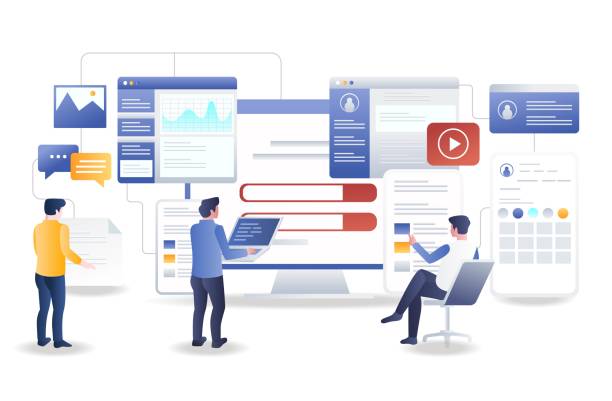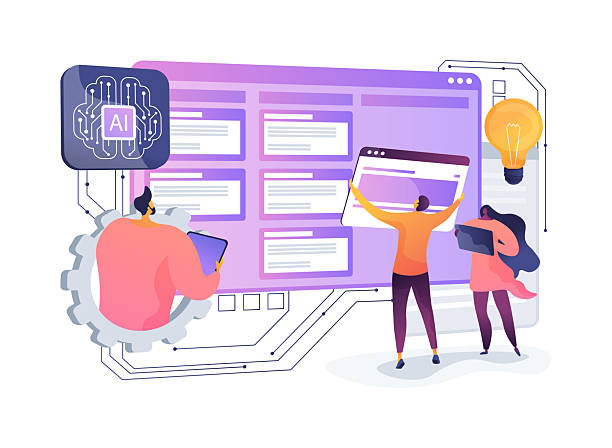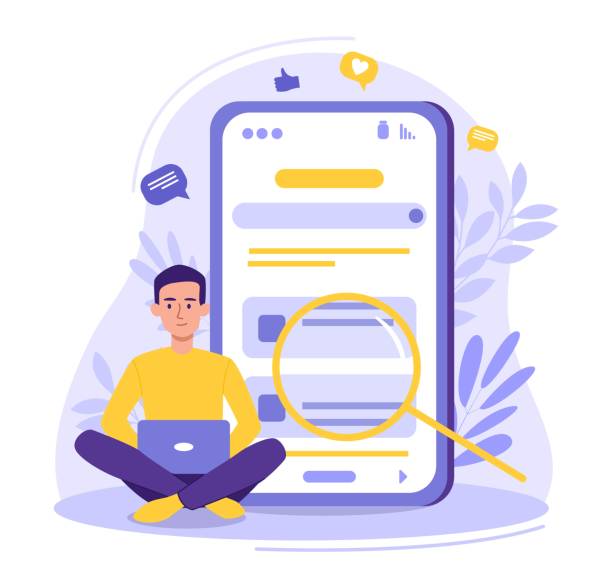Introduction to the Importance of User-Friendly Website Design in Today’s Digital World

In the current era, where online competition has reached its peak, merely having a website is not enough.
What truly makes a difference is the quality of the user experience provided by that site.
#User-friendly website design is no longer a competitive advantage; it is a vital necessity for the survival and growth of any business in the online space.
When users visit your website, they expect to easily find content, have easy navigation, and complete necessary processes, such as purchasing or registering, without any obstacles.
If your website fails to meet these expectations, users are likely to quickly leave and go to your competitors.
This issue increases the bounce rate and ultimately harms your site’s SEO ranking.
A website with user-centric design not only increases customer satisfaction but also significantly helps improve conversion rates, increase user time on site, and consequently, enhance your position in search engine results.
Focusing on user experience means understanding the needs and behaviors of your audience and building a visual and functional path that guides them towards their goals.
This approach forms the foundation of every successful digital marketing strategy and ensures that your website investment yields optimal returns.
In fact, User Experience (UX) design and User Interface (UI) design are two main pillars for achieving a truly user-friendly website, which we will discuss in detail in the following sections.
Are you falling behind in the competition with large online stores?
RasaWeb makes your business online and increases your market share with professional e-commerce website design!
✅ Increase brand credibility and customer trust
✅ Easy shopping experience leads to more sales
⚡ Act now to get a free website design consultation!
Fundamental Principles of User Experience (UX) and User Interface (UI) Design
![]()
User-friendly website design is directly related to the concepts of UX and UI.
In fact, these two concepts are the main pillars of building a website that not only looks beautiful but also functions well.
User Experience (UX) refers to all aspects of a user’s interaction with your product or service.
This includes how the user feels when using the site, the ease of access to information, and the efficiency of various processes.
An excellent UX design guides the user at every step of the journey, from entering the site to reaching the final goal (such as purchasing a product), ensuring that this path is as smooth and friction-less as possible.
On the other hand, User Interface (UI) relates to the visual and interactive layout of elements on the website, such as buttons, forms, typography, colors, and images.
Good UI means aesthetics and visual appeal, while good UX means functionality and efficiency.
These two concepts are inseparable; a beautiful UI without strong UX is merely an empty shell, and strong UX without an attractive UI might be overlooked.
To achieve a user-friendly website design, these principles must be considered:
- Usability: The site should be easy to use, and users should be able to complete their tasks quickly.
- Accessibility: The site should be accessible to all users, including those with disabilities.
- Value: The site should provide real value to users and meet their needs.
- Desirability: The site should be attractive and engage users.
- Findability: Content should be easily searchable and discoverable on the site.
The correct combination of these principles helps you create a user-friendly and efficient website that not only attracts visitors but also converts them into loyal customers.
Ultimately, focusing on small details in UI design can have a significant impact on the overall user experience of the website and differentiate it from your competitors.
The Role of User Research and Understanding in the Process of Optimizing a Site for Users

No successful user-friendly website design is possible without a deep understanding of its target users.
User research and audience understanding are the heart of any effective design process.
Before even a line of code is written or a visual element is designed, designers and developers must answer the question: “Who are my users? What are their needs? How will they use my website?” This stage involves collecting data through various methods such as user interviews, surveys, focus groups, and analysis of behavioral data (like heatmaps and user session recordings).
The results of these studies provide valuable insights into user expectations, challenges, and preferences.
For example, you might discover that your users mostly access the site via mobile, or that they are looking for specific information that is not currently easily accessible.
This information helps you create User Personas that represent examples of your main users with their demographic characteristics, goals, and pain points.
These personas serve as guides throughout the design process and ensure that every design decision is based on actual user needs.
Using this information, you can map out User Journeys, which show how users navigate through the site to achieve their goals.
This analytical process provides a solid foundation for optimizing the site for users and prevents guesswork in design.
Deep user understanding not only helps you build a functional site but also enables you to create an emotional and positive experience for them, leading to loyalty and repeat visits.
This is what distinguishes a truly user-centric website from others.
Key Stages in User Research:
| Stage | Description | Tools/Methods |
|---|---|---|
| 1. Define Objectives |
Specify what you want to learn from the research. | Research questions, project goals |
| 2. Select Methods |
Choose the best methods for data collection. | Interviews, surveys, usability testing |
| 3. Data Collection |
Execute research and collect information. | Questionnaires, session recordings, statistical analysis |
| 4. Analysis and Interpretation |
Review data and extract patterns and insights. | Persona creation, user journey maps |
| 5. Present Findings |
Share results with the design team and stakeholders. | Reports, presentations, diagrams |
Optimizing Site Speed and Performance for Increased User Satisfaction

In today’s world, user patience with slow websites has significantly decreased.
If your website takes more than a few seconds to load, you will likely lose many of your visitors.
This not only negatively impacts the user experience but can also severely damage your SEO ranking.
User-friendly website design means paying special attention to speed and performance.
Users expect pages to load quickly, interactive elements to respond without delay, and transitions between pages to be smooth and seamless.
From Google‘s perspective, site speed is one of the important ranking factors, as it directly affects user experience.
To improve your website’s speed and performance, several key actions can be taken.
First, image optimization is essential.
Large image files can significantly reduce loading speed.
Using optimized image formats (such as WebP) and compressing images without losing quality are fundamental steps.
Second, minification of CSS, JavaScript, and HTML code can reduce file sizes and improve loading speed.
Third, using a caching system allows users’ browsers to store static site files, enabling faster loading on subsequent visits.
Fourth, choosing a powerful and reputable hosting provider with fast servers and sufficient bandwidth plays a crucial role in overall site performance.
Additionally, enabling GZIP compression and using a CDN (Content Delivery Network) to distribute content from the nearest server to the user can make a significant difference in speed.
A high-speed website not only means greater user satisfaction but also leads to increased conversion rates and reduced bounce rates.
This is an essential investment for any business that wants to succeed in the digital space and provide a flawless user experience.
Are you tired of losing business opportunities due to not having a professional corporate website?
RasaWeb helps you with professional corporate website design:
✅ Build a powerful and reliable brand image
✅ Convert website visitors into loyal customers
⚡ Get a free consultation now!
Responsive Design and Compatibility with Various Devices: A Modern Imperative

In today’s world, where using smartphones and tablets to access the internet has become a standard, user-friendly website design is virtually meaningless without Responsive Design.
Responsive design means building a website that automatically adapts its layout and elements to the screen size of the device the user is employing.
This means that a site should look equally good and function flawlessly on desktops, laptops, tablets, and mobile phones.
The reason for this importance is clear: if users are forced to zoom in to view content on their phones, perform horizontal scrolls, or struggle to press small buttons, they will quickly become frustrated and leave your site.
Google is also increasingly emphasizing Mobile-First Indexing, meaning it considers the mobile version of your site as the primary version for ranking.
Therefore, if your site is not optimized for mobile, you will not only provide a poor user experience but also perform poorly in search results.
Implementing responsive design involves using flexible grids, fluid images, and CSS media queries.
These techniques ensure that your site remains readable, clickable, and efficient regardless of the device used.
A site with a good and responsive user interface not only makes information more accessible but also helps increase user engagement, reduce bounce rates, and ultimately improve conversion rates.
Ultimately, investing in responsive design is an investment in the future of your business and ensures that your site is usable for all users, anytime, anywhere.
The Importance of Engaging and Accessible Content in User Attraction

Alongside attractive visual design and strong technical performance, user-friendly website design is heavily dependent on its content.
Content is king; this phrase has been repeated many times and still holds true in the digital world.
Your content should not only be informative and relevant but also presented in a way that is engaging and accessible to users.
Does your content answer user questions? Is it written in a way that is understandable to your target audience? Is it easily scannable and readable? These are questions you should ask yourself when creating content for a user-friendly website.
Engaging content can take the form of text, images, videos, infographics, or podcasts.
The important thing is that the content creates added value and encourages user interaction.
For example, using clear headings, short paragraphs, bullet points, and lists significantly increases text readability.
Including high-quality images and videos can also help in better understanding the subject and enrich the user’s visual experience.
Furthermore, optimizing content for SEO is essential.
Using relevant keywords, attractive meta descriptions, and a logical URL structure helps search engines better understand your content and display it to appropriate users.
Good content not only conveys information but also builds trust, demonstrates your authority in your field, and converts users into loyal customers.
A strong content strategy is an inseparable part of every successful user-friendly website design, as it gives users a reason to stay on your site and return again.
Using User Feedback for Continuous Improvement of User-Friendly Websites

A user-friendly website design is not a static process; rather, it requires continuous improvement and adaptation to changing user needs.
One of the most powerful tools for achieving this goal is collecting and analyzing user feedback.
Direct feedback from those who actually use your website can reveal strengths and weaknesses that might have remained hidden from developers and designers.
Do users have trouble finding specific information? Is the payment process complicated? Do color schemes or fonts hinder readability? These are just a few examples of questions that can be answered by gathering feedback.
There are various methods for collecting feedback, including in-site surveys that are displayed at the moment of user interaction with the site, direct feedback forms, heatmap analysis, and session recordings that show exactly how users navigate the site and what difficulties they encounter.
Additionally, A/B testing allows you to test different versions of a page or element and see which one performs better.
After data collection, the critical stage of analysis begins.
Transforming this raw data into actionable insights is the key to improvement.
The design and development team should regularly review this feedback and implement necessary changes to optimize the user experience.
A feedback-driven site not only grows continuously but also gives users the feeling that their opinions are valuable and influential in decision-making.
This agile and user-centric approach ensures that your site always aligns with changing user needs and truly remains a user-friendly site.
Common User Feedback Collection Tools:
| Tool | Application | Examples |
|---|---|---|
| Website Surveys | Collecting quantitative and qualitative feedback from users. | SurveyMonkey, Typeform |
| Heatmaps and Session Recordings | Analyzing users’ visual behavior on the site. | Hotjar, Crazy Egg |
| Usability Testing | Observing users performing real tasks. | UserTesting, Lookback |
| Customer Relationship Management (CRM) Systems | Collecting and organizing feedback through support channels. | Zendesk, Salesforce |
| Social Networks and Forums | Monitoring public discussions and opinions about the brand. | Twitter, Reddit, Facebook Groups |
Security and Privacy in User-Friendly Website Design

In the information age, data security and privacy are no longer just technical issues; they have become an inseparable part of user-friendly website design.
Users expect their personal information, whether during purchase or registration, to remain in a secure and confidential environment.
Data breaches can not only severely damage your business’s reputation but also lead to a loss of user trust and heavy legal penalties.
Therefore, every user-centric website must be designed from the outset with the highest standards of security and privacy in mind.
The first crucial step is using an SSL/TLS certificate, which encrypts communications between the user’s browser and the server.
This is indicated by “https” in the browser’s address bar and a lock icon, assuring users that their information is secure.
Furthermore, strong password management, Two-Factor Authentication (2FA), and regular software and plugin updates prevent security attacks.
From a privacy perspective, transparency regarding how user data is collected, stored, and used is highly important.
A Privacy Policy should be clearly and simply drafted and easily accessible to users.
Compliance with regulations such as GDPR (General Data Protection Regulation) in Europe and CCPA (California Consumer Privacy Act) in the US is essential for websites with international audiences.
Designing a highly secure site not only protects your business but also builds user trust, assuring them that they can use your services with peace of mind.
This is especially critical in sectors like e-commerce, where users enter their financial information.
Are you tired of your e-commerce site having visitors but no sales? RasaWeb solves your main problem with professional e-commerce website designs!
✅ Significant sales increase with targeted design
✅ Flawless user experience for your customers
⚡ Get a free consultation!
Challenges of User-Friendly Website Design for Startups

Startups often face limited resources and tight deadlines, but this should by no means imply neglecting the importance of user-friendly website design.
In fact, for startups, a website with an excellent user experience can create a significant differentiation in the market and help them quickly attract and retain users.
However, this path is not without challenges.
One of the biggest challenges is budget constraints.
Hiring expert UX/UI teams or investing in expensive tools might be impossible for a startup.
This can lead to the use of pre-made templates or low-cost designs that may not be optimal.
Another challenge is the lack of initial user data.
Startups usually do not have a large user database to analyze behavior and feedback.
This makes the process of understanding users and designing based on their actual needs difficult.
Additionally, the pressure for quick time-to-market can force designers to cut corners and neglect critical UX design stages.
The result can be a functional site, but not necessarily a user-friendly one.
To overcome these challenges, startups can use Agile Design methodologies, which involve rapid iterations and early feedback collection from a limited number of users.
Also, using free or low-cost tools for user research and usability testing can be beneficial.
Smart investment in an optimized user interface website from the beginning, even if on a small scale, can prevent costly revisions in the future and help the startup build a strong foundation for growth and development.
The Future of Website Design and the Continuous Importance of User-Centricity

The world of the web is constantly evolving, and new technologies are rapidly emerging.
However, one principle remains constant: user-friendly website design will never lose its importance.
In fact, with advancements like Artificial Intelligence (AI), Virtual Reality (VR), and Augmented Reality (AR), the concept of user-centricity becomes even more complex and critical.
The future of web design is moving towards more personalized, interactive, and immersive experiences.
AI can help websites personalize content based on each user’s history and preferences, while VR and AR can offer entirely new ways to interact with products and services.
Despite these advanced technologies, the fundamental principles of excellent user experience will remain: simplicity, usability, accessibility, and meaningful connection.
The main challenge for future designers is to integrate these novel technologies in a way that truly enhances the user experience, rather than being merely a technological innovation without purpose.
Websites should evolve into smarter platforms that anticipate user needs and quickly provide appropriate solutions.
This requires a deeper understanding of user psychology and the ability to use data for design decisions.
Businesses that understand this trend and invest in user-centric design will not only lead the competition but also build deeper and more meaningful relationships with their customers.
Ultimately, the future of websites is not just about their appearance, but about the feeling they evoke in users and the efficiency they bring to them.
Frequently Asked Questions
And other services of Rasa Web Advertising Agency in the field of advertising
- Smart Conversion Rate Optimization: A new service for increasing sales through Google Ads management.
- Smart Conversion Rate Optimization: Designed for businesses seeking to increase sales through intelligent data analysis.
- Smart Link Building: Professional optimization to increase website traffic using precise audience targeting.
- Smart Native Advertising (Reportage): A creative platform to improve website traffic with marketing automation.
- Smart Social Media: A combination of creativity and technology to increase click-through rates through precise audience targeting.
And over a hundred other services in the field of internet advertising, advertising consultation, and organizational solutions.
Internet Advertising | Advertising Strategy | Native Advertising
Resources
The Importance of User-Friendly Website Design for SEO
Principles of Improving User Experience (UX) on Websites
Advantages of Having a Professional Website for Business
How to Design a Successful and High-Traffic Website?
? Build your online business future today with Rasaweb Afarin, a leading digital marketing agency. We pave your path to success by providing innovative and specialized solutions, including multilingual website design, SEO, and targeted social media management. Trust us to shine in the digital world.
📍 Tehran, Mirdamad Street, next to Bank Markazi, Southern Kazerun Alley, Ramin Alley, No. 6



